
In this blog post, we examine a 12-slot, 10-pole permanent magnet (PM) machine modeled in the COMSOL Multiphysics® software and AC/DC Module. The machine in this example serves as a representative example of a rotating device and has an outer diameter of 35 mm and axial length of 80 mm. With slight modifications to the input conditions, the same model can become a motor or generator. In upcoming blog posts, we will elaborate on each of the design aspects discussed here.
This is the first blog post in a series discussing how to obtain insights into some design aspects of rotating machines using the modeling and postprocessing capabilities of the COMSOL Multiphysics® software. Part 2 covers computing loss, temperature, and efficiency in electric motors.
Electric Motors and Generator Designs: Model Setup
In a permanent magnet motor, the magnetic fields from the rotor rotate in synchronization with the magnetic fields generated by the stator currents. The interaction of rotor and stator magnetic fields generates the net torque that is making the motor able to convert the windings’ currents into mechanical power. As a consequence of the synchronous nature of the excitation, in a permanent magnet motor, the instantaneous torque is influenced strongly by the rotor angular position — as the position is in sync with the stator currents. This is different in asynchronous machines where the stator windings induce the rotor magnetic fields as a function of the lag in speed between the rotor and the stator (hence its popular name, induction machine).
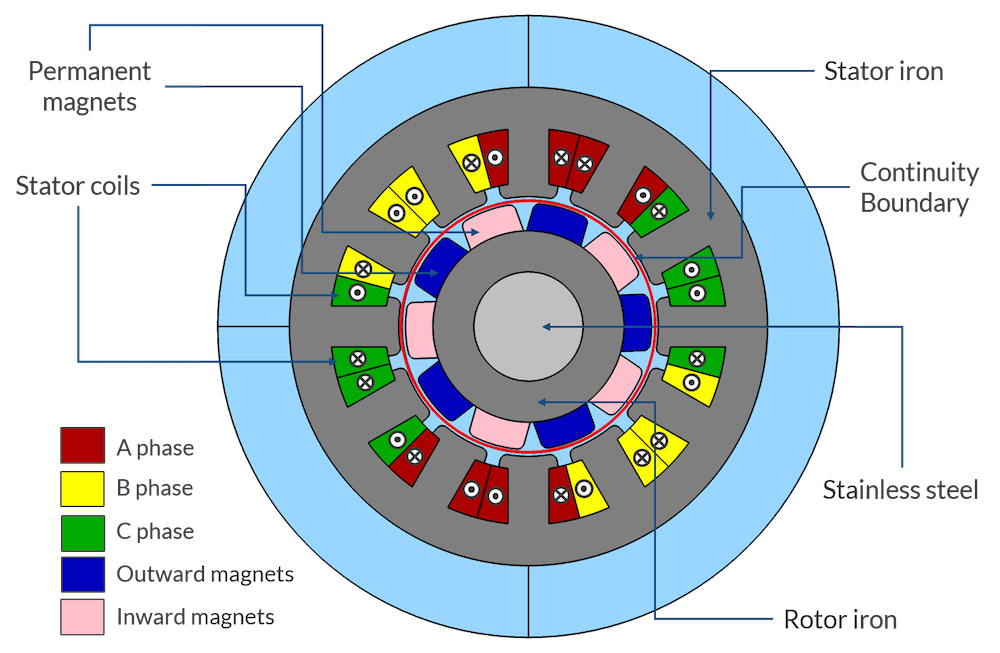
Schematic of the permanent magnet machine model.
The coil excitation will have the form: I = I_m cos(\kappa \alpha + \phi), where I_m is the peak current, \kappa is a scaling factor dependent on the number of poles, \alpha is the rotor angle, and \phi is the phase angle. In this example, the excitation for the three phases is given by: I_a = I_m cos(\kappa \alpha), I_b = I_m cos(\kappa \alpha – {120}^{\circ}), and I_c = I_m cos(\kappa \alpha – {240}^{\circ}), respectively.
To ensure that the attractive and repulsive forces between the stator and the rotor poles produce a unidirectional torque, the scaling factor \kappa has to be such that the fields from the stator coils reverse direction when the rotor moves by an angular span of one rotor magnet (the magnets have an alternating polarity). Its value is given by \kappa = \frac{{180}^{\circ}}{{360}^{\circ}/N_p}, where N_p is the number of rotor poles. The denominator gives the angular span of a single rotor pole.
Investigating and Optimizing the Magnetic Field Distribution
The magnetic field distribution is a very important factor in the design of electrical machines. In synchronous rotating machines, a key parameter for investigating induced voltages is the spatial distribution of the air gap flux (the flux exchanged between rotor and stator). The stator phase voltage will be sinusoidal only if the radial magnetic flux has a sinusoidal distribution along the rotor periphery. This spatial waveform is also referred to as the air gap magnetomotive force (MMF) wave. If the MMF wave is nonsinusoidal, higher-order harmonics are introduced in the induced voltage.
In this model, in order to obtain the air gap MMF wave, we evaluate the radial component of the magnetic flux density along the continuity boundary. As the rotor rotates, we can observe how the MMF wave evolves over time. Simply by inspection, we can understand that the induced voltage will not be perfectly sinusoidal. In the upcoming blog series, we will explain how to obtain the space and time Fourier transforms of the air gap magnetic flux, and how to relate them to the concatenated flux and the harmonic distortion of the voltage.
Left: Magnetic flux density variation with rotor rotation. Right: Progression of the air gap MMF wave with rotor rotation.
Investigating and Optimizing the Mechanical Torque
There are several ways to excite the stator windings for a particular slot/pole combination of a PM motor. The pattern shown in the schematic of the permanent magnet machine model (the first figure in the blog post) is one way in which a 12-slot, 10-pole PM motor can be driven. The stator coil excitation (or the initial rotor position) needs to be adjusted such that a maximum amount of torque is applied to the rotor. In order to do so, the rotor is given an initial angular displacement. The rotor angle \alpha is varied over an angular span of one rotor magnet, and the average torque is calculated. The value of initial angular displacement that corresponds to the maximum average torque is chosen as the initial position of the rotor. In this manner, it becomes easier to visualize what relative position of the stator and rotor produces maximum torque.
In the case presented here, two maxima are observed:
- Positive maximum that will correspond to an electric machine operating in motoring mode, i.e. converting electric power to mechanical power
- Negative maximum that will correspond to an electric machine operating in generating mode, i.e. converting mechanical power to electric power
The rotor torque waveform given in the next section corresponds to the positive maximum of the average rotor torque curve. We will look deeper into torque inspection and various methods of torque computation, such as Arkkio’s method and the virtual work principle, in upcoming blog posts.
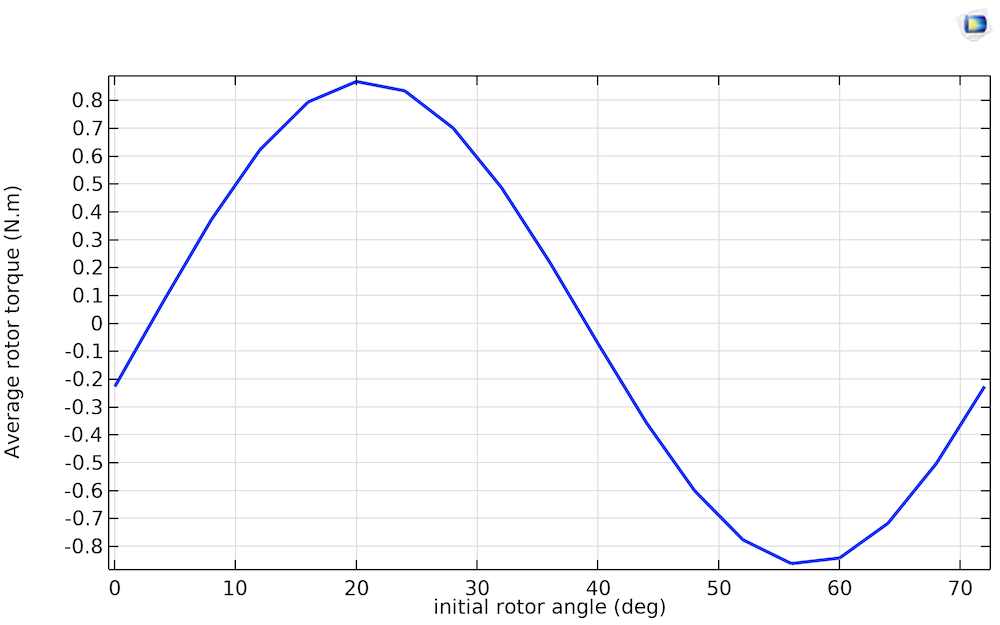
Variation of the average rotor torque with the initial rotor angle over the span of two rotor poles (2 \times \frac{{360}^{\circ}}{N_p} = {72}^{\circ}).
Investigating and Optimizing the Iron Usage and the Losses
By using a magnetic flux density plot, we can investigate the flux density distribution in the iron core. In some portions of the geometry, the yoke may form a bottleneck, which may push the magnetic flux density value into the saturation region of the B-H curve. In others, it is wide enough to cause regions of low field intensity. When a certain part of the yoke consistently shows a weak field, that part is underutilized for torque production. When a certain part forms a consistent bottleneck, that part should probably be widened.
In the example, the iron thickness in the rotor and stator is varied, and its effect on the rotor torque is examined. For generating a maximum amount of torque, the initial rotor angle is set to {20}^{\circ}, as obtained from the average torque curve in the previous section. As you can see from the plots and the torque curve below, the iron utilization is optimal when the iron thickness is about 2 mm: Going for less than 2 mm will have a negative effect on the torque, and going for more will add unnecessary material — and therefore; weight and cost — to the motor.
Magnetic flux density distribution for different values of iron thickness. Left: 1 mm. Center: 2 mm. Right: 3 mm.
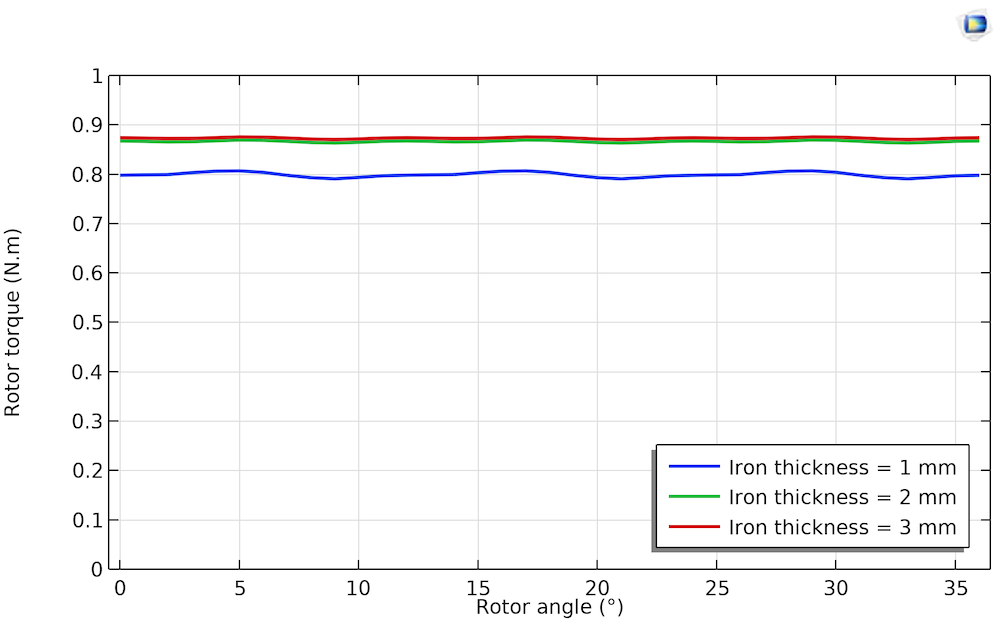
Rotor torque waveform variation with iron thickness.
This isn’t the whole story though: There are additional considerations when determining the iron thickness, such as the mechanical strength and resistive and magnetic losses. When doing the investigation on the flux density and torque, the effect of the varying iron thickness on the iron losses can be evaluated as well. As of COMSOL Multiphysics version 5.6, there is a built-in Loss Calculation feature to easily assess the copper losses and iron losses using the Steinmetz equation, Bertotti formulation, or a user-defined loss model. In upcoming blog posts, we will further discuss the multiphysics aspects of rotating machine modeling, such as efficiency calculation, temperature rise assessment, vibration analysis, and noise examination.
Iron loss distribution for different values of iron thickness. Left: 1 mm. Center: 2 mm. Right: 3 mm.
Summary
We have discussed the use of some functionality provided by COMSOL Multiphysics and the AC/DC Module to easily get insights into a few design aspects of rotating machines. We have seen how the line graph of the radial magnetic flux density in the air gap shows us whether the induced voltage will be sinusoidal. Using COMSOL Multiphysics, a Parametric Sweep can be used to determine the initial rotor angle that will produce the maximum rotor torque. The surface plot of the magnetic flux density in the machine enables you to visually determine whether the utilization of the iron is optimal for efficient torque production. The effect of the iron thickness on the iron losses can be observed as well, using the built-in loss models offered by COMSOL Multiphysics.
This first blog post in the series illustrates how the powerful modeling and postprocessing capabilities of COMSOL Multiphysics can be used to gain valuable insights into rotating machine design. The blog posts that follow will extensively discuss torque computation methods, efficiency calculation, analysis of iron losses and thermal performance, and motor vibration and noise examination. Stay tuned!
Try It Yourself
Try modeling the electric motor discussed here by clicking the button below:


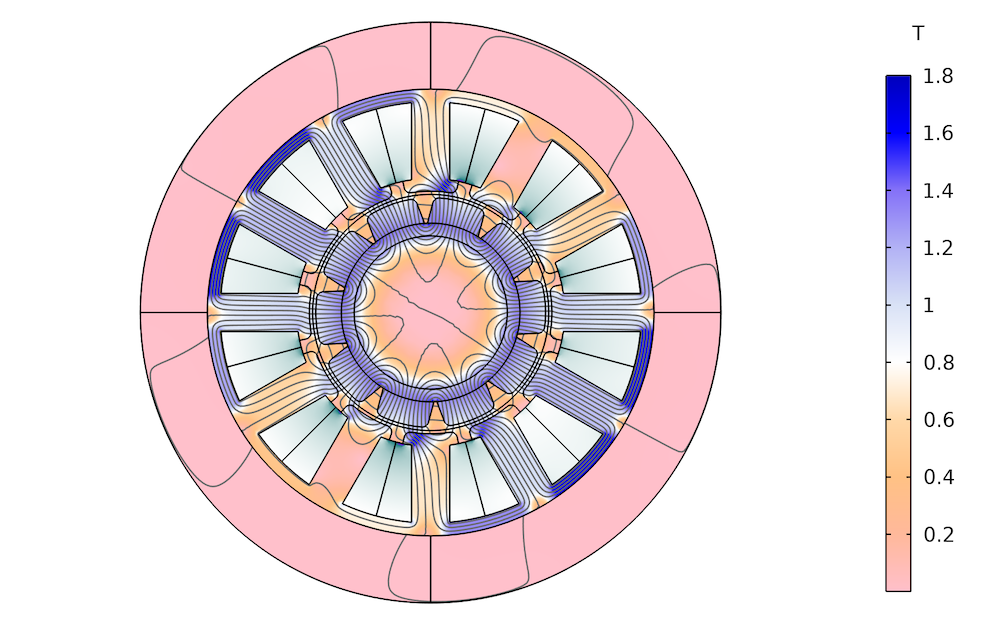
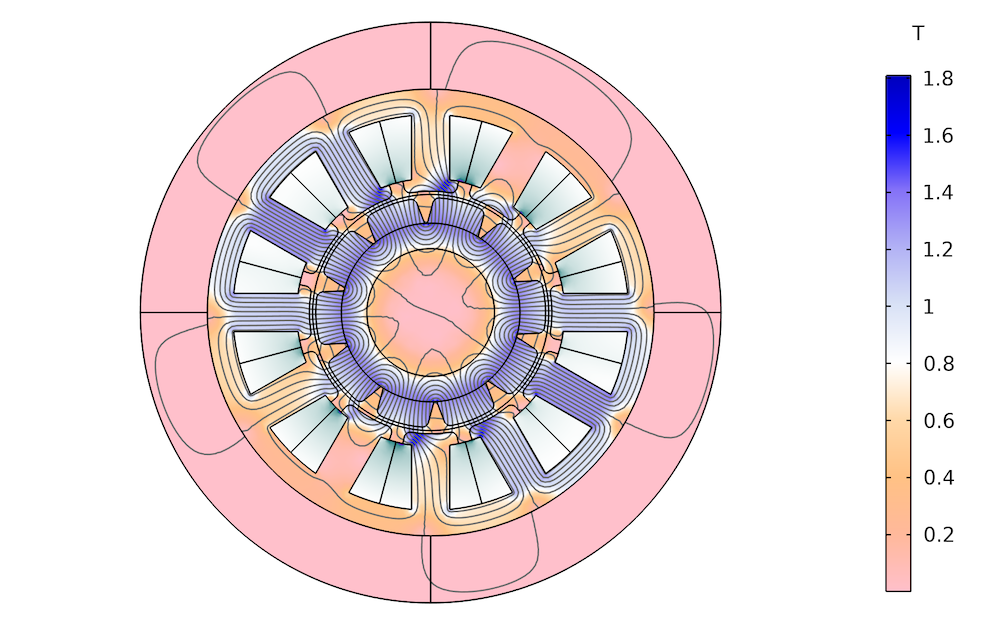
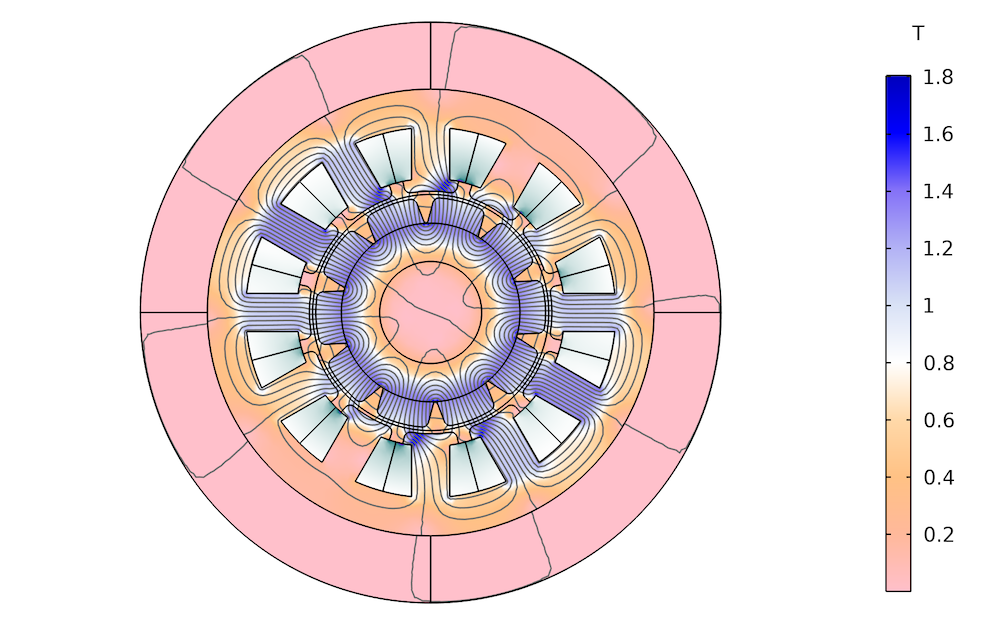

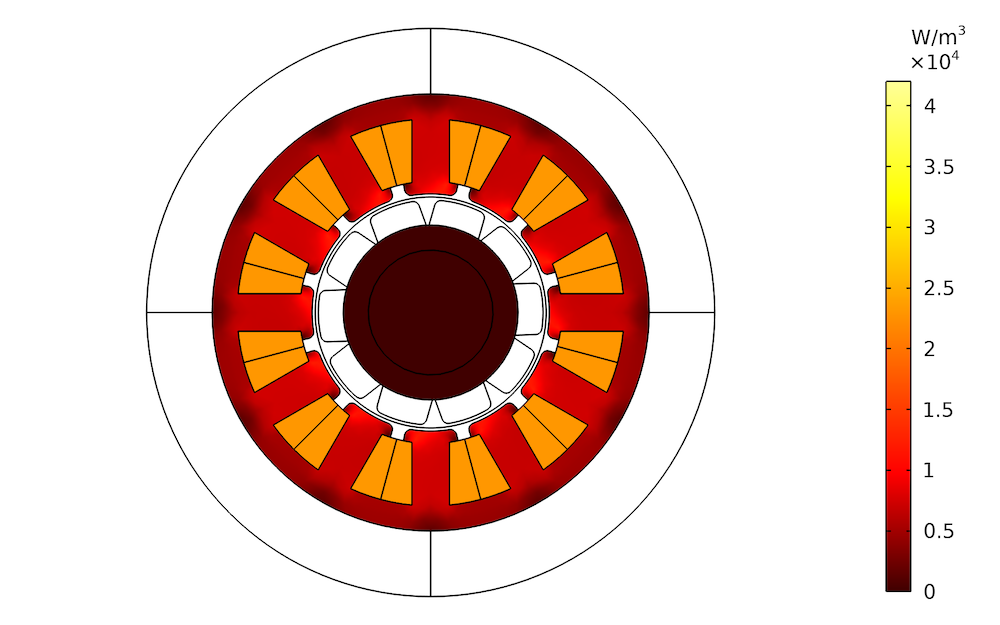
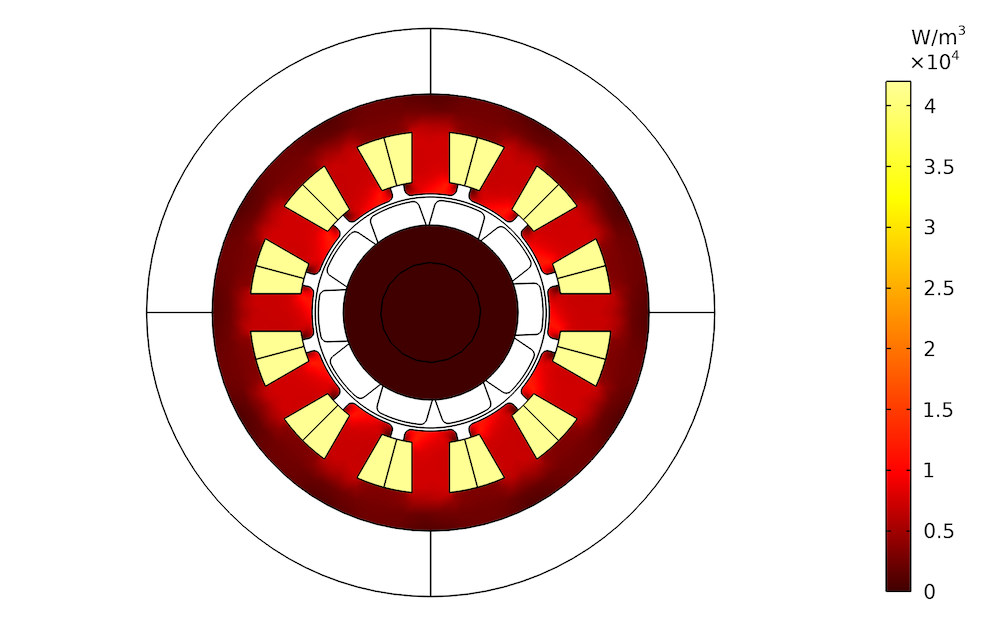

Comments (17)
Ethan Hunter
April 19, 2021Electric motors work by converting electrical energy to mechanical energy in order to create motion. Force is generated within the motor through the interaction between a magnetic field and winding alternating (AC) or direct (DC) current. Towing Aurora Colorado
Cesare Tozzo
May 5, 2021 COMSOL EmployeeThank you for making even more clear Rahul’s sentence “The interaction of rotor and stator magnetic fields generates the net torque that is making the motor able to convert the windings’ currents into mechanical power.” Do not hesitate to contact us for any specific request.
Carlos Azcarraga
April 29, 2021Hello! I have a question not fully related with the model you share. I’m trying to model a 150 slot synchronous generator. It has two coil sides per slot. it has fractionary pitch and distributed winding. I draw a cross-sectional view of it (2D). My question is: is it possible to connect individual coils in series in some way? for example, let’s consider two coils A and B. Each coil has two end sides, A1, A2, B1 and B2. I inject current in end A1, the current enters to the plane and exits in A2 with opposite sign (the same coil, just different current direction). How can I connect this point, A2, with B1 in order to make a series conection of both coils? thanks in advance!
Cesare Tozzo
May 5, 2021 COMSOL EmployeeYes, this is possible (and very typical). The specific way could be partially model dependent. As an example also at the model that you can download at https://www.comsol.com/model/analyzing-electric-motor-and-generator-designs-97091 features the functionality “Reverse current direction” in connection to the “Coil group” checkbox. That functionality can most of the time be used as it is for your purpose (if I got your question properly). For any other model specific related requests, we will be happy to answer to your questions, but please contact us from support@comsol.com
Nguyen Thanh Hai
July 8, 2021Dear Mr. Rahul Bhat,
Thank you for your blog post.
I honestly look forward to your next post.
Best regards,
Nguyen Thanh Hai.
Rahul Bhat
July 9, 2021Dear Nguyen,
Thank you for the appreciation!
We shall soon publish the next blog article on losses, temperature rise and efficiency map.
Regards,
Rahul
胜平 毛
July 13, 2021Thank you for your blog.
I tried the mph file and I found something weird. If I let the rotor rotate in the opposite direction, and I will get a sinusoidal-like torque rather than a constant torque. Moreover, I added the dynamic rotating speed variables by a rigid body rotation following the 2D induction motor example, again I get the sinusoidal-like torque and alternating rotating speed. Could you explain a bit more about my puzzle?
Thanks in advance.
Shengping
Rahul Bhat
July 14, 2021Thanks Shengping for that interesting question. Perhaps you could share your model with us at support@comsol.com. Then we can have a closer look at it and resolve your query.
Le Chi Hieu
June 1, 2022Dear Mr. Rahul Bhat,
I am Le Chi Hieu – I used to ask you a lot of advice from you about the permanent magnet generator.
Thank you for your support!
Best regards,
Le Chi Hieu
Rahul Bhat
June 7, 2022Dear Le Chi Hieu,
Thank you for the appreciation! It is my pleasure!
Regards,
Rahul
Jiawei Tian
September 15, 2022Hello,
I have a question about the mechanical requirement. How can we model the centrifugal force on the rotor?
Thanks.
Rahul Bhat
May 22, 2023Hi Jiawei,
You can couple the RMM interface with Solid Mechanics to obtain the centrifugal force on the rotor.
Mechtex Pvt Ltd
November 12, 2022Pretty interesting and informative blog!!
If you are interested in checking out my blog, I have attached the links below
Blog: https://www.mechtex.com/blog/synchronous-motors10
Do like and comment 🙂
Rahul Bhat
May 22, 2023Thank you for the appreciation!
Qi Wang
May 19, 2023Where can we find the blog about ”the space and time Fourier transforms of the air gap magnetic flux”?
Warnakulasooriya Sandaruwani
September 4, 2024Hello, I want to make a simulate to find energy gap between 12 pulse VFD, 3-phase induction motor and impeller. Can I use Comsol Multiphysics software for this?
Evan Sisler
September 6, 2024 COMSOL EmployeeHi Warnakulasooriya,
Thank you for your comment.
What you’re describing sounds like an interesting problem.
If you’re looking to engage other COMSOL users, we would encourage you to post on the discussion forum: https://www.comsol.com/forum
And if you’d like to contact a COMSOL representative to discuss this problem further, please fill out the following form: https://www.comsol.com/contact